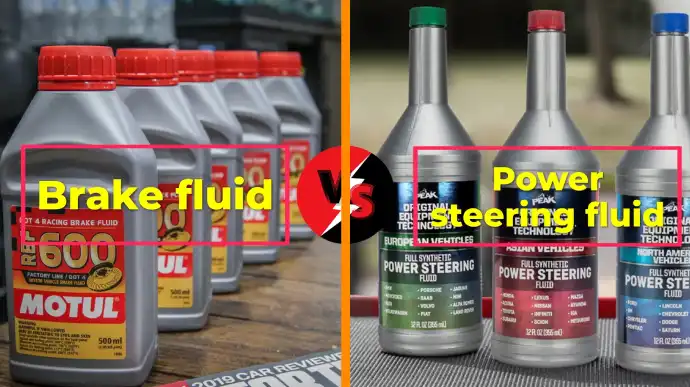Physical Address
304 North Cardinal St.
Dorchester Center, MA 02124
Physical Address
304 North Cardinal St.
Dorchester Center, MA 02124

Maintaining your vehicle’s fluid systems is essential for safety and optimal performance. Two critical fluids in your vehicle are brake fluid and power steering fluid. While they might seem similar, they serve distinct functions and significantly differ.
Brake fluid transfers force to the brake pads to stop the vehicle motion. This fluid contains glycol ethers or silicone-based compounds for anti-corrosion. However, power steering fluid reduces steering effort while turning the vehicle. This fluid includes mineral oil or synthetic fluids for easy maintenance.
As part of this article, we’ll explore the major differences between these fluids to help you understand their importance and avoid potential mishaps. So keep reading for detailed information.

When comparing brake fluid and power steering fluid for vehicles, several key differences exist.
Brake fluid is primarily used in the braking system, and its main purpose is to transfer force into pressure, amplifying the braking force. It ensures that when you press the car brake pedal, the given force is transmitted directly to the brakes, enabling efficient and safe stopping.
On the other hand, power steering fluid is used in the power steering system to enhance steering effort by reducing engine drag. It optimizes the performance of the power steering system, making it easier for drivers to turn the wheels, and acts as a lubricant for various steering mechanisms, minimizing wear and tear.
Brake fluid is typically glycol-based or silicone-based, chosen for its high boiling point to prevent vaporization during braking.
Glycol-based brake fluids, such as glycol-ether, are commonly used due to their superior performance in high-temperature environments. These fluids also resist moisture absorption, ensuring consistent performance over time.
Conversely, power steering fluid can have various compositions, including mineral oil-based or synthetic blends. The formulation of the power steering fluid aims to optimize the performance of the power steering system, providing lubrication to metal components and minimizing wear and tear.
Brake fluid is typically clear to yellowish in color, allowing for easy inspection of its condition and level in the reservoir. Its transparency is a key characteristic that distinguishes it from power steering fluid and other vehicle fluids.
Alternatively, power steering fluid can vary in color, often appearing as red, brown, or even green, depending on the manufacturer and type of fluid. This variation in color serves as a distinguishing feature, aiding in identifying power steering fluid.
Brake fluid is susceptible to moisture absorption, which can lead to contamination and compromise the efficiency of your braking system as time passes. Regular maintenance and periodic replacement are crucial to ensure the reliable performance of your brakes.
However, power steering fluid can also become contaminated over time, but the sources of contamination are different. Contaminants in power steering fluid can hinder the smooth operation of the steering system and potentially cause wear and damage.
Brake fluid, being non-compressible, plays a critical role in ensuring consistent and reliable brake performance. When you press the brake pedal, the force is transmitted directly to the brake system without any yielding to pressure.
This non-compressible nature allows for immediate response and effective braking, ensuring your safety on the road.
On the other hand, the power steering fluid is compressible, serving a different purpose. Its compressibility allows smoother and easier steering by reducing the effort required to turn the car’s wheels. This makes steering more effortless and enhances the overall driving experience.

Vehicle manufacturers often recommend specific types such as DOT 3, DOT 4, or DOT 5 for brake fluid. These types have different characteristics and are suitable for different applications. Follow the manufacturer’s recommendations as they consider factors like system design and expected usage.
Power steering fluid, however, can vary depending on the vehicle manufacturer and system design. It may include synthetic, nonsynthetic, or automatic transmission fluid (ATF). To ensure the functionality and longevity of your power steering system, select the appropriate power steering fluid recommended by the manufacturer.
Brake fluid typically has a high boiling point, exceeding 300°C (572°F). This high boiling point is crucial as it ensures the stability and effectiveness of the fluid, even under extreme braking conditions.
On the other hand, power steering fluid also possesses a high boiling point, approximately 600 degrees Fahrenheit. This characteristic is essential for preventing overheating of the power steering pump and maintaining the functionality of the steering system.
Brake fluid is carefully formulated to be compatible with the braking system’s rubber seals and hoses. This compatibility is crucial as it prevents corrosion and ensures the long-term effectiveness of the braking system.
In contrast, a power steering fluid is designed to preserve the power steering pump and keep the steering mechanism well-lubricated. Using the correct fluid is essential for preventing damage to system components and ensuring smooth steering operation.
Brake fluid, being hygroscopic, can attract and retain moisture from the surrounding environment. This characteristic prevents moisture buildup within the brake system, as moisture can lower the fluid’s boiling point.
In contrast, power steering fluid doesn’t exhibit hygroscopic properties. While it enhances steering and lubricates components, its primary function doesn’t include preventing moisture accumulation. Therefore, power steering fluid isn’t designed to absorb moisture like brake fluid actively.
| Aspect | Brake Fluid | Power Steering Fluid |
| Purpose and Function | Transfers force into pressure for efficient braking. | Enhances steering effort and lubricates steering components. |
| Chemical Composition | Typically glycol-based (e.g., glycol-ether or silicone). | Can be mineral oil-based, synthetic, or other blends. |
| Compressibility | Non-compressible; maintains consistent pressure. | Compressible; reduces steering effort. |
| Boiling Point | High boiling point, typically 300°C (572°F). | High boiling point 600°F. |
| Compatibility with System Components | Compatible with hoses and rubber seals. | Designed to preserve power steering pump and lubricate components. |
| Hygroscopic Properties | Hygroscopic; absorbs moisture to prevent system corrosion. | Non-hygroscopic; focuses on steering and lubrication. |
| Fluid Color | Typically clear to yellowish. | Varies in color (red, brown, or green). |
| System Control | Critical for braking control, ensuring vehicle stops effectively. | Enhances steering control, reducing effort for the driver. |
| Contamination and Maintenance | Susceptible to moisture contamination; requires regular replacement. | Prone to contamination, necessitating maintenance for optimal performance. |
| Fluid Types and Manufacturer Recommendations | Different types (e.g., DOT 3, DOT 4, DOT 5); manufacturer recommendations vary. | Varied types based on manufacturer and system design; follow manufacturer recommendations. |
You can’t use brake fluid in power steering. Brake and power steering fluids aren’t interchangeable due to their different properties and compositions.
Brake fluid is specifically formulated to withstand high temperatures and provide hydraulic pressure to the braking system. It’s designed to have a high boiling point and low compressibility to ensure efficient brake operation.
On the other hand, the power steering fluid is formulated to lubricate and protect the power steering system, reducing friction and wear. It doesn’t have the same high boiling point or hydraulic properties as brake fluid.
Using brake fluid in power steering can cause damage to the power steering system, including seal swelling and blocking passages, leading to a loss of power steering functionality.
Using DOT 4 brake fluid in your power steering system may have damaging effects. While brake fluid and power steering fluid serve as hydraulic fluids, they’re formulated differently to meet the specific requirements of each system.
DOT 4 brake fluid is designed to withstand high temperatures and provide excellent braking performance.
However, it lacks the necessary additives and properties for optimal power steering system operation. Brake fluid may cause seals and other rubber components in the power steering system to deteriorate, leading to leaks and potential system failure.
Using ATF as a power steering fluid can lead to potential issues and should be avoided. Although some ATF types, such as Dexron and Mercon, can be used in certain power steering systems, it’s important to exercise caution.
While ATF is designed to provide lubrication and heat dissipation in automatic transmissions, power steering fluid has specific properties tailored to the needs of power steering systems. A power steering fluid is a non-oil-based fluid created in a lab, making it different from ATF.
Using ATF in a power steering system can affect the performance and longevity of the components, potentially leading to leaks, increased wear, and diminished power steering capabilities.

To accurately check the power steering fluid level, turning off the engine and locating the power steering reservoir is important. This ensures the fluid isn’t in motion and provides an accurate reading.
Checking the power steering fluid with the engine off also reduces the risk of injury, as the power steering system can be pressurized when the engine is running.
Once the engine is off, you can easily locate the power steering reservoir, typically labeled and located near the front of the engine compartment. Confirm that it’s indeed the power steering reservoir by checking the label on the cap.
Understanding the differences between brake fluid and power steering fluid is crucial for vehicle maintenance and safety. While it may be tempting to use brake fluid in power steering or vice versa, doing so can lead to serious damage to your vehicle’s systems.
Always consult your vehicle’s manual or a professional mechanic to ensure you use the correct fluid. Regular maintenance and periodic replacement of these fluids will help keep your vehicle’s braking and steering systems in top condition, ensuring safety and longevity.